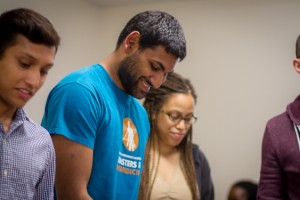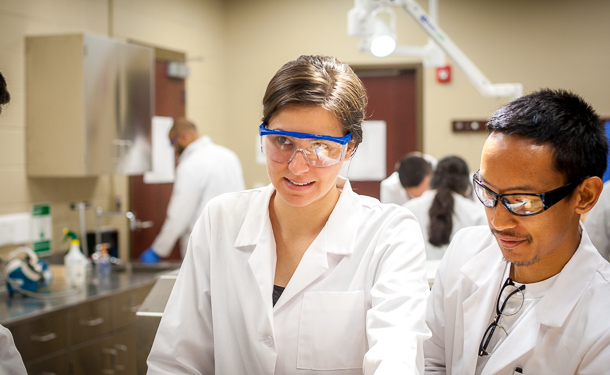Jared Fernandez didn’t have to go far to find a research topic for his master’s in biomedicine thesis. Not only is “vaping” with E-cigarettes, or E-cigs, a growing trend among young people, but Fernandez knew just about everyone, including scientists in the biotechnology industry, wanted to know more about the health claims of electronic cigarettes and the liquid that is burned to create the vapors.
This nudged the second-year graduate student to more investigation: Was vaping as healthy as manufacturers claimed?
For Fernandez, as well as four master’s in biomedicine candidates at Eastern Mennonite University who defended their theses on Dec. 5, the research process was much more than the sum of the parts.
“I appreciated applying scientific concepts to real world questions that were medically and socially relevant,” said Fernandez, who has received acceptance letters from two medical schools for next year.
Independent research guided by professors
Professor Julia Halterman, Fernandez’s advisor, teaches the summer research methods and the fall data methods courses that guide students through the research project, which is the culmination of the five-semester course of study.
“In the summer, the students develop their topic, go through the Institutional Review Board process, create methods and gather data,” she explained. “In the fall class, we look at data analysis and the writing of the manuscript.”
A committee of three professors from different disciplines guides each student through the rigors of research. “We advise carefully, because this is a big investment of time and energy from the student, and an important learning experience,” Halterman said. “You really don’t know how to do research until you create a project of your own and go through the process. There’s troubleshooting, and navigation of politics of different institutions and organizations, and learning how to work with people.”
The process-oriented, hands-on approach is excellent preparation for careers in biomedicine or for medical school, Halterman says. “Most students don’t have any experience with original hypothesis-driven research and this really makes them stand out when they apply to medical or dental school.”
The research project is the final component of a four-part program that includes coursework, a cross-cultural experience and a practicum experience. Transdisciplinary approaches to problem-solving are used and encouraged as students and faculty engage in a curriculum that integrates the natural and medical sciences with faith and ethics, Halterman says, a unique training that also positions students to be collaborative and holistic investigators.
Fall 2015 Research Projects
Rachel Thomas: “A Data Analysis on Demographic Information of Patients with ADHD at [local medical practice]”
Thomas, who works in healthcare and has a goal of becoming a physician’s assistant, says her interest arose from her own awareness of the high rates of ADHD diagnosis. She analyzed demographical data from an area medical practice to identify correlations between adult ADHS and gender, race/ethnicity and socioeconomic status. In demographical analyses of childhood ADHD already done by other researchers, ADHD was more frequently observed in Caucasians and in males. The data set included more than 970 patients ranging in age from 18-65+ and confirmed that a diagnosis of adult ADHS was more likely to be seen in Caucasion men than in other populations. Her research will be used to help identify and treat adult patients with ADHD. Committee members: Drs. Kim Brenneman and Tara Kishbaugh.
Hannah Bell: “Women’s Awareness of Risk Factors Linked to Breast Cancer in Harrisonburg, Virginia”
Bell conducted a survey in which 60 female respondents self-reported their knowledge about obesity and breast cancer. She found that women in Harrisonburg did not fully understand the risk factors of breast cancer, including the role of postmenopausal obesity. Though the survey only covered a small population, it affirmed the need to raise awareness among the local population about the risk factors. Committee members: Drs. Carolyn Stauffer and Jeff Copeland.

Vipul Nayani: “The Effect of Collegiate Athletic Training Duration on Athlete Injury Incidence”
Nayani, a 2014 Virginia Tech graduate who plans to become a family physician, developed this project with an interest in “multifactorial” causes and individual proclivities toward injury. He observed a correlation between training time and injury, with evidence suggesting that more than 18 hours of weekly athletic training were 23% more likely to develop athletic injuries than athletes that trained for fewer than 18 hours per week. Committee Members: Drs. Roman Miller and Carolyn Stauffer.
Tareq Yousef: “Cost Analysis of Dental Services Before and After the Implementation of the Affordable Care Act in the Washington, D.C. Metropolitan Area and the Shenandoah Valley Region of Virginia”

Yousef, who has an undergraduate degree from George Washington University in public health, wanted a research topic that integrated current political events with healthcare, and specifically dentistry, his future profession. He studied the effect of the Medical Device Excise Tax, which supports the Affordable Care Act and is levied on device manufacturers, on the cost of oral health services in dental offices and labs. Statistically significant changes in cost of services were reported for all of the lab services as well as some dental procedures. Committee members: Drs. Ann Hershberger and Roman Miller.
Jared Fernandez: “Carcinogenic Compounds Created by the Vaporization of Electronic Cigarette Liquid: Effects of Variable Voltage within the Modified Electronic Cigarette”
Fernandez’s research, outlined briefly above, hypothesized that there would be positive correlation between the voltage setting of the modified E-cig and the amount of carcinogens within the vapor produced from one modified E-cig design. While no detectable amounts of carcinogens were produced in his data set, Fernandez found that the content of the vapor is significantly different depending on the voltage. Furthermore, increased voltage may increase inflammatory responses in human lungs regardless of flavoring additives due to increased concentrations within inhaled vapors. These findings suggest additional research is required to further characterize E-cig effects on human health. Committee members: Drs. Matthew Siderhurst and Daniel King.
